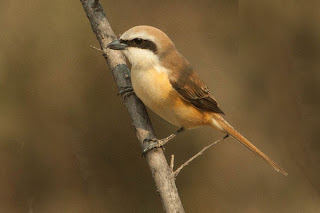It’s fair to say that we’ve had one or two distractions and diversions from our normal routine during the past month, some of them planned but others not so. However, in spite of these there has been plenty of birding to enjoy.
European Roller
Montagu's Harrier
Visits to the Castro Verde area have been fewer of late. In contrast to the wonderful display of wildflowers that we were seeing earlier, the landscape is now looking very parched and straw-coloured as crops of hay and cereals have been harvested. As the breeding season progresses, both species of bustards have become more difficult to see and now Montagu’s Harriers, Lesser Kestrels and Rollers are among the most conspicuous birds as they go looking for food for newly hatched young. Also regularly seen have been Collared Pratincoles, Calandra Larks and Black-eared Wheatears and the number and variety of raptors has guaranteed regular roadside stops to check them out.
Black-eared Wheatear
In the Algarve, we’ve made only a couple of visits to Ludo and Quinta do Lago and most of our birding has been around Castro Marim. It’s been very convenient to have several pairs of breeding Collared Pratincoles easily viewable and Little Bustards were also good while they lasted although impossible to find once they stopped displaying. More often heard than seen have been several pairs of Water Rails. About 20 Slender-billed Gulls and up to about 10 Caspian Terns have been regular and in the past few days the number and variety of waders has increased with Black-tailed Godwits, Red Knot, Curlew Sandpiper, Sanderling, Turnstone and Dunlin all in smart breeding plumage. There are waders in the Ria Formosa, too, and Audouin’s Gulls are ever present.
By way of a change, we recently spent a morning just a few kilometres inland from Tavira, sitting in the car by the roadside next to a small river. The aim was photography but we weren’t very successful! However, from that one spot we were able to watch a surprising variety of species that included Golden Orioles (a pair with three young), Kingfisher, Bee-eater, Little Ringed Plover, Green Sandpiper, Grey Wagtail, Rock Bunting, Blue Rock Thrush, Turtle Dove, Crested Tit, Long-tailed Tit and Azure-winged Magpie. Only a Green Sandpiper and a Grey Wagtail came close to performing for the camera on this occasion but when we have time to return to this delightful location we will be hoping to have some more of these birds coming down to the water.
Grey Wagtail
Green Sandpiper
Earlier this week we popped across the border to Spain, to the Doñana area. Unfortunately, the White-headed Ducks that June found on her last visit in May were nowhere to be seen but we did see five Red-knobbed Coots, a species that we don’t often find in Portugal. It was good to see that the visitor centre at the Dehesa de Abajo is now regularly open and we met up there with ‘old friends’ Beltran Ceballos Vázquez and Sergio González who regaled us with stories of the latest sightings of Iberian Lynx. Huge numbers of Glossy Ibises were a feature of the day with nice views of them nesting at the José Antonio Valverde visitor centre alongside many Cattle Egrets and smaller numbers of Little Egrets, Squacco Herons, Little Bitterns and Black-crowned Night Herons. Elsewhere there seemed to be plenty of our favourite Purple Herons feeding well-grown young hidden deep in the tamarisks.
Cattle Egret
Purple Heron
Black-crowned Night Heron
In the Tavira area, the ‘best’ bird we have heard of was one that we didn’t manage to see even though it was apparently around for several days. It was in the mouth of the harbour and described to us by a non-birder friend as “looking like a penguin”. Previous reports of penguin-like birds have usually involved pale-fronted immature Great Cormorants but when we eventually saw the photographs, this one proved to be a first-winter Atlantic Puffin, somewhat unexpected at this time of year. What a pity that we didn’t get a phone call until long after the bird had gone!

































